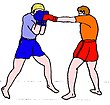Cover (combat technique)
defense technique in physical combat
In combat sports like fencing, boxing, karate, etc., the cover is a defensive movement permitting to protect oneself against strikes by placing a weapon or a body part like the fist, forearm, elbow, arm or shoulder before the aim aimed by this attack.

This form of defence, so-called "passive", is different from the block or parry that are considered "active". The cover has nearly the same meaning as "protection" especially in boxing when a fighter raises his arm in order to protect his face or head against a possible attack.
One puts cover to use:
- in expecting way in case of the opponent's attack, especially in order to protect his or her own forward movement (example: raising the shoulder before the jaw, covering oneself with the arm and the glove)
- in instantaneous (i.e. happening at once) way when the opponent's attack is launched.
In boxing and boxe pieds-poings
changeThe cover in boxing is a form of defence commonly used in the hand-to-hand situations and when the fighter suffers by a large number of strikes.
-
Side cover by the glove during an attack of roundhouse kick
-
Side cover by the arm and the glove during an attack of crescent kick
-
Cover so-called "roof of the house" during an attack of overcut
-
Cover by the shoulder during an attack of cross of the rear arm
Sources
change- Georges Blanchet, Boxe et sports de combat en éducation physique, Ed. Chiron, Paris, 1947
- Alain Delmas, 1. Lexique de la boxe et des autres boxes (Document fédéral de formation d’entraîneur), Aix-en-Provence, 1981-2005 - 2. Lexique de combatique (Document fédéral de formation d’entraîneur), Toulouse, 1975-1980.
- Jack Dempsey, Championship fighting, Ed. Jack Cuddy, 1950
- Gabrielle & Roland Habersetzer, Encyclopédie des arts martiaux de l'Extrême-Orient, Ed. Amphora, Paris, 2000
- Louis Lerda, J.C. Casteyre, Sachons boxer, Ed. Vigot, Paris, 1944
- Marcel Petit, Boxe: technique et entraînement, Paris, Ed. Amphora, Paris, 1972
Wikimedia Commons has media related to Boxing.
Other websites
change- (in French) Antenna WKA-France - Lexicon of the boxes pieds-poings (Column "Formations", onglet "Ceinture noire")
- (in French) Lexicon of Netboxe.com Archived 2008-12-19 at the Wayback Machine
- (in French) Practical sheets of Netboxe.com Archived 2009-01-22 at the Wayback Machine
- (in English) BoxRec Boxing Encyclopaedia